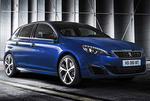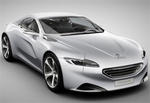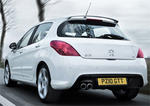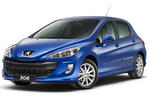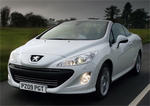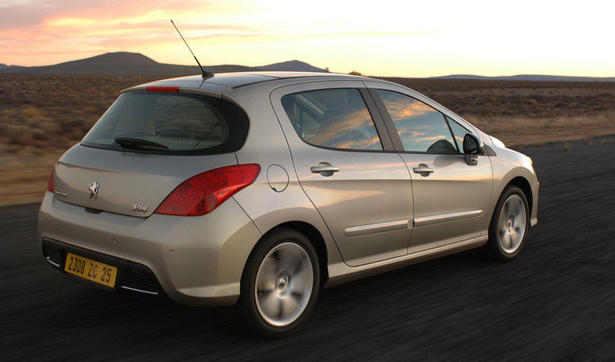
Peugeot Press RElease:
Peugeot 308, naturally efficient
AT ITS LAUNCH IN SEPTEMBER THE 308 WILL BECOME THE FIRST MODEL TO CARRY A NUMBER ENDING IN 8. IT WILL BUILD ON THE STRENGTHS OF ITS PREDECESSOR, OF WHICH MORE THAN THREE MILLION HAVE BEEN SOLD IN 6 YEARS, THANKS TO ITS CONCEPT BASED ON A SEMI-HIGH ARCHITECTURE, DESIGN, INTERIOR SPACE, INTERIOR LIGHT LEVELS AND A UNANIMOUSLY RECOGNISED HIGH STANDARD OF ROAD HOLDING. AS A VEHICLE OF A NEW GENERATION, IT DEVELOPS FURTHER THE PLUS POINTS AND AT THE SAME TIME DEVELOPS
NEW ONES, MAINLY IN FAVOUR OF ENVIRONMENTAL EFFICIENCY AND QUALITY.
Peugeot, as an environmentally conscious manufacturer, has made the reduction of greenhouse gas emissions a key priority. In keeping with recent Peugeot models, the 308 was designed with the protection of the environment as a key requirement. This has been achieved through the use of technology solely dedicated to improving its environmental efficiency.
With this aim in mind, particular attention has been paid to aerodynamics in order to improve
the overall performance. As a result, the 308 has a low drag resistance (SCx 0.67 and Cx 0.29),
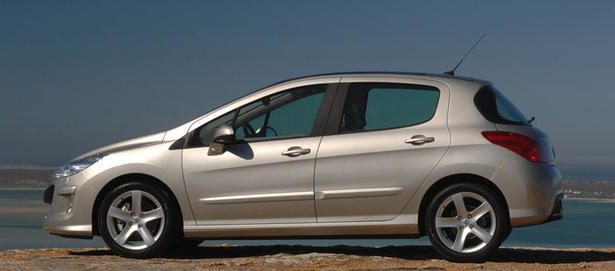
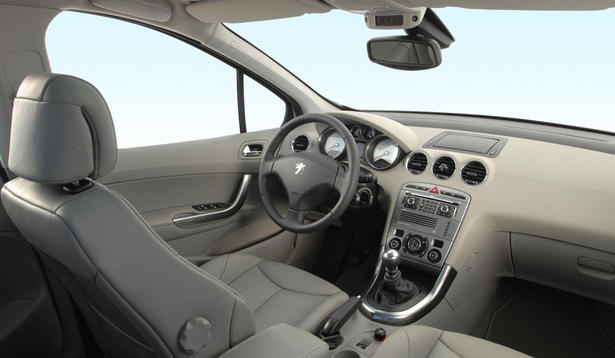
resulting in a reduction in fuel consumption and CO2 emissions.
The 308 will be available with a choice of six lean burn engines, including three petrol engines, developed as part of the partnership with the BMW Group, and three HDi diesel engines, one of which will have an emission level of 120 g CO2 per kilometre in the combined cycle.
In addition to the engine range available, the designers of the 308 have also used different solutions to improve environmental effi ciency. Consequently, the 308 will have a manual gearbox
with an electronic control system, electro-hydraulic power assisted steering and new Michelin Energy Saver tyres, to achieve a signifi cant reduction in fuel consumption and therefore in exhaust emissions. Finally, the European End-of-Life Vehicles Directive has been taken into account in the choice of materials allowing the recycling or re-use of 99% of the 308.
The 308 project has benefi ted from the full attention and creative energy of the Peugeot
engineers and designers, who have committed themselves to create a car whose quality is of the
highest standard. Designed by the Peugeot
Design Centre, the elegant, sporty lines of the 308 invoke dynamism and effi ciency, whereas
the forms and materials of the interior offer the
occupants a prestigious style and fi nish. But
the design – the fi rst “force” of the emotion and
feeling that triggers the ultimate act of buying –
has exceeded its aesthetic function, by also
emphasising the perceived quality of the vehicle.
Quality has also occupied pride of place in the
industrial plan implemented to produce the
308, giving rise two a twophase launch strategy.
Consequently, the initial launch will concentrate on the core range, consisting of the fi ve door version with four engine options, before being expanded in a second phase to the three door
version and other engines.
In designing the 308 it was not sufficient just
to rely on the qualities of the interior, the high
levels of interior light and the driving pleasure
that contributed to the success of the 307, but
instead evolve these in order to take them to a
new level. This applies particularly to the interior, which takes full advantage of the available length of 4,276 m to establish what will be a reference in the segment. The interior light levels have been improved even more thanks to the fi tment of a glass panoramic roof; which provides a total glazed area of 4.86 m2. With this confi guration the fi ve door hatchback offers overhead natural light to all the passengers on board. And fi nally, Peugeot’s know-how with regard to suspension systems has resulted in choices that give the 308 a high level of driving pleasure and an excellent
compromise between comfort and effi ciency.
In addition to its exemplary handling, the 308 is
equipped with technology aimed at providing the highest levels of safety. This includes, the Lane
Departure Warning System (LDWS) for the benefi t
of primary safety, the airbags, which can number
up to nine, for secondary safety, and fi nally, the Peugeot Emergency Service (emergency call)
linked to the RT4 telematics system, for tertiary
safety.
With the 308, Peugeot is offering a vehicle that
will meet the expectations of customers of the
compact hatchback market, which is the largest
market because of the volumes it generates
in Western Europe in particular. In fact, with
nearly fi ve million vehicle registrations in 2006, it represents approximately one third of the allbrands market and has increased slightly since 2001, the year when the 307 was fi rst introduced.
This market is made up of a diverse clientele.
Although essentially made up of families, this
clientele has a varied profi le; both in terms
of age and car experience, but they all want a
prestigious vehicle that does not compromise on
performance.
The 308 will be launched within a particularly
short time frame, the day after the Frankfurt
Motor Show, where it will have its world premiere.
The 308 will be available in the main European
countries between the 20th September – the date
of the commercial launch in France – and the 27th
September.
This new hatchback will be made at Sochaux, the
historic home of Peugeot, and Mulhouse.
Peugeot 308 : natural efficiency
Peugeot’s new model in the medium car range,
the 308 is the fi rst car of the new “8” generation. It is fi tting that this new hatchback should share the semi-tall architecture which fi rst appeared on the 307. It enables, in addition to the recognised qualities of all of the Marque’s models (dynamic styling, class leading handling, etc), an optimised
specifi cation for this type of body shape.
It provides interior space, visibility, brightness and compact packaging and the qualitative points of reference which have already won more than three million buyers for the 307 worldwide.
The 308 therefore builds on the 307’s technical
platform, but develops it further in order to meet
the project’s high objectives: an assertive style,
comprehensive specifi cation and a high level of
quality.
During its design, the engineers and stylists have
paid particular attention to the perceived quality
and “quality feel”.
With the 308, Peugeot has blended in all the
ingredients to appeal to a highly diversifi ed
customer base in search of self expression,
modernity, attention to detail, control and
convenience.
An exterior style more feline than ever
The 308 embodies in its own way the characteristic Peugeot genes that give all of the
Marque’s models their strong identity. Strengthening the obvious feline look is two
designs of “front” both with a different fi nish
depending on the model: one is a “classic” style
(for the entry level model); the other is more
dynamic or “sporty”.
The strongly contoured lines of the “nose” of the
car serve as the focal point and create a dynamic
and fl owing “V” profi le which follows back from
the bonnet into the front windscreen pillars.
The profi le of the 308 creates a dynamic impression of movement, thanks to the elaborately styled panels and fl owing design of the windows.
The lines at the rear of the vehicle help to identify it. The large wrap around lower bumper – which on top-of-the-range models combines with a
rear diffuser – and large rear lights emphasises
the wider rear profi le and the large curved rear
tailgate glass.
A new and original interior
The style of the interior is perfectly in keeping
with the exterior architecture, with the adoption
of a steeply inclined fascia panel to accentuate
the feeling of space. Its fl uid and elegant
design coupled with the use of high quality
materials (both to look at and to touch) creates
an impression of quality seldom encountered in
models in this market segment. The use of large
expanses of glass combined with a panoramic
glass roof (as standard or as an option depending
on version) creates a bright interior conducive to
user-friendliness and the wellbeing of occupants.
Rear passengers will be particularly at ease in the 308 thanks to its generous interior space resulting from its architecture and the design of the front seats.
The attention to detail enjoyed by the occupants
of the 308 is part of an approach designed to
ensure their utmost wellbeing, thanks in particular to important work carried out on the control of the interior temperature and noise insulation, and also the availability of numerous and ingenious storage spaces.
Dynamic effi ciency: exceptional road holding
The chassis and suspension of the 308,
assisted by the excellent body rigidity, have
been meticulously developed to obtain the best
possible combination of road holding and comfort,
making the 308 a benchmark in its category.
The electro-hydraulic power steering offers the
driver maximum precision, assured by pseudo
McPherson type front struts and a rear torsion
beam. In addition, a wider front and rear track and larger tyres (up to 18’’) enhances the overall effi ciency of the vehicle.
Environmental efficiency
The search to lessen the environmental impact
of the vehicle was a key objective in all stages
of development of the 308. Whether it was with
regards to recycling, aerodynamics, its petrol
and diesel engines based on recent or original
technology, the additive-based diesel particle
fi lter system on the HDi diesel versions, its wheels and suspension (including Michelin Energy Saver tyres and electro-hydraulic power steering),
reducing weight (involving the use of composite
materials, aluminium and high-strength steel),
everything has been carefully studied to
optimise fuel consumption and reduce CO2
emissions. Indeed, the CO2 emissions of the
1.6 litre HDi 66kW (90bhp) 308 has been reduced
to just 120 g in the combined cycle.
A wide range of modern, high-performance engines
that are economical and environmentally-friendly
The 308 offers a wide choice of power trains;
there are 10 in all, to meet the requirements of
the broadest possible customer base: three
petrol engines, three HDi diesel engines and
five gearboxes.
Maximum efficiency in terms of safety
The objective to provide exemplary road holding
forms the basis of the primary safety of the 308.
This is supplemented by a range of equipment
such as a Lane Departure Warning System
(LDWS) and bi-Xenon directional headlamps.
At the level of secondary safety, the structure
(particularly through the use of 3 impact
absorption structures at the front) and
bodywork that has been designed in terms of
its rigidity and ability to deform in a controlled
manner, provides optimal impact protection.
In addition, the 308 can be equipped with up to
9 airbags, including 2 rear side air bags and a
steering column air bag.
According to countries, the “Peugeot Emergency”
service, linked to the RT4 telematics system,
ensures tertiary safety by pinpointing the
vehicle’s location and organising the dispatch of
appropriate assistance.
Colours, trims and structure of the range
With 12 exterior body colours, 5 trim levels,
different choices of interior ambience, cloth or
leather trim, and even an integral leather fascia
panel, the 308 knows how to play the “exclusive”
card to appeal to customers.
Architecture
Exceptional style, road holding and aerodynamics
The platform
The “T7” project is based on platform 2 of
the PSA Peugeot Citroën group. This ensures
straight away that the 308 had a solid foundation
for its development.
This platform, modifi ed and optimised, stands
out due to its excellent rigidity, ensuring optimal performance of the mechanical assemblies and suspension but also providing good noise and
vibration suppression.
Exterior dimensions
Through its exterior dimensions, the 308 offers
an excellent compromise between interior space
and overall dimensions.
• A length of 4.276 m, or only 74 mm more than
the 307 despite a very high level of safety and
repairability, with:
- a wheelbase of 2.61 m, that favours interior
space - the same as that of the 307,
- a front overhang restricted to 926 mm (48 mm
more than the 307) and a rear overhang of
742 mm (+ 26 mm compared to the 307).
• A generous width of 1.815 m, an increase of
85 mm compared to the 307, ensuring excellent
lateral passive safety and interior passenger
compartment width.
• A height, which continues to set the car apart in the compact saloon segment and makes possible
its generous interior space - 1.498 m (12 mm less
than the 307 as a result of the optimised styling
and aerodynamics).
Similarly, to meet the requirements of the styling
and road holding, the front and rear tracks have
been widened compared to those of the 307
(e.g. with 15’’ wheels):
• 1.536 m for the front track (+ 30 mm compared
to the 307 with equivalent wheels)
• 1.531 m for the rear track (+16 mm compared
to the 307).
Larger wheels, clad with 195/65R15, 205/55R16,
215/55R16, 225/45R17 and even 225/40R18 tyres
(available on numerous versions), also enhances
the general style of the 308 and its road holding
effi ciency.
With its new and optimised architecture, its wider
front and rear tracks and height reduced by 12 mm,
thereby accentuating its dynamic and elegant
style, the 308 promises a level of road holding in
keeping with the expectations of the Marque.
Aerodynamics
The styling and dimensions of this new Peugeot
allow for a particularly effi cient aerodynamic
specifi cation. Indeed in this respect, the 308
is clearly one step ahead of its predecessor;
its exceptional Cx of 0.29 is better than that of
competitor’s fi ve door models. This excellent
result and the SCx that results (0.67), despite
a cross sectional area (S) of 2.3 m2 due to the
height and width of the car, is the result of
extensive work carried out in the wind tunnel on
the vehicle’s body.
The final result is a reduction in fuel consumption combined with low running costs and optimal environmental effi ciency.
Engines
A range of modern, effi cient and environmentally-friendly engines
Shortly after the launch the 308 will be available
with a wide choice of ten different power trains
which will meet the different requirements of
the largest possible number of customers in the
segment.
For the petrol versions, the 308 will be equipped
with all new engines designed and developed in
partnership between the PSA Peugeot Citroën
and the BMW Group: the 1.4 litre and 1.6 litre VTi
engines and also the 1.6 litre THP in its 110 kW
(≈ 150 bhp) version. All benefit from particularly
innovative technology, if not wholly original at this level of engine capacity.
For the HDi diesel versions, the 308 is powered
by the recent 1.6 litre 66 and 80 kW (≈ 90 and
110 bhp) engines and the 2.0 HDi developing a
power of 100 kW (≈136bhp), acknowledged for
their driveability, performance and low running
costs. An additive based diesel particle fi lter
system comes as standard with the 80 and
100 kW engines.
Petrol Engines
1.6 litre THP: 110 kW (≈ 150 bhp) – EP6DT (*)
The 1.6 litre THP (“Turbo High Pressure”), with
a capacity of 1598 cm3, available in the 308
offers great operating fl exibility thanks to its
maximum torque of 240 Nm available from only
1400 rpm and ensures a remarkable driveability
at low engine speeds. It produces a maximum
power of 110 kW at 5800 rpm (103 kW at
6000 rpm in the automatic gearbox version).
Its innovative Twin-Scroll turbocharger combines
exhaust gases in an optimal fashion to ensure
maximum pressure with minimal lag, while its
high-pressure direct petrol injection system
improves combustion and the engine’s overall
effi ciency.
On the 308, this system creates a remarkable
synthesis of performance and fuel consumption.
For example, it takes the car only 8.8 s to go from 0 to 100 kph, with driver only, and in gear
acceleration is exceptional: 7.8 s in 4th gear
from 80 to 120 kph, with a petrol consumption of
7.1 litres/100 km in the combined cycle.
1.6 litre VTi: 88 kW (≈ 120 bhp) – EP6 (*)
The 1.6 litre VTi (Variable Valve Lift and Timing
injection) is an indirect injection naturally aspirated engine developing a maximum power of 88 kW (≈ 120 bhp) at 6000 rpm and a maximum torque
of 160 Nm at 4250 rpm. This torque is available
very uniformly, since even at low engine speeds
(2,000 rpm), it attains 140 Nm, or 88 % of its
maximum capacity, thereby ensuring a wide
operating range.
1.4 litre VTi: 70 kW (≈ 95 bhp) – EP3
The newest arrival in the recent family of “EP”
engines, this 1398 cm3 engine develops a power
of 70 kW at 6000 rpm and a torque of 136 Nm at
4000 rpm. It also produces 86 % of its maximum
torque, i.e. 117 Nm, at only 2000 rpm.
Apart from the smaller capacity resulting from
a shorter stroke, this engine features all of the
technology found on the 1.6 VTi engine, such as
the dual VVT system and the variable inlet valve
lift system. This is no mean technological feat
on a small 1.4 litre engine; the latter enables the basic level 308 to offer an excellent compromise between drive ability and fuel consumption.
HDi Diesel engines
2.0 litre HDi DPFS: 100 kW (≈ 136 bhp) –
DW10BTED4 (*) With a capacity of 1997 cm3, the “DW10B” develops a maximum power of 100 kW at
4000 rpm and a generous maximum torque of
320 Nm at 2000 rpm.
This torque can even attain 340 Nm thanks to
the “overboost” function activated during hard
acceleration, making for example overtaking
much safer.
To obtain this outstanding performance, the
engine is equipped with a variable geometry
turbocharger, an electronically controlled highpressure pump (allowing a maximum pressure
of 1650 bar in the common rail according to
required load) and piezoelectric injectors with
six apertures which send a fi ne spray of fuel into the combustion chamber (resulting in optimal
injection both in terms of quantity and duration).
This engine gives the 308 a dynamism that
accentuates its road holding. With driver only,
it accelerates from 0 to 100 kph in 10.1 s and in
5th gear from 80 to 120 kph in 8.4 s, while limiting fuel consumption to 5.5 litres / 100 km in the combined cycle.
1.6 litre HDi DPFS: 80 kW (≈ 110 bhp) – DV6TED4 (*) Delivering a maximum power of 80 kW at 4000 rpm, this 1560 cm3 HDi engine equipped with a diesel particle fi lter system is characterised by its remarkable responsiveness and fl exibility, with a maximum torque of 240 Nm from 1750 rpm. These characteristics are attained thanks to technologies such as its variable geometry turbocharger and its high-pressure direct injection system (up to 1600 bar). This maximum torque can be increased momentarily to 260 Nm thanks to the “overboost” function.
This engine, which will form the “base of the
diesel range” of the 308, thus offering an
excellent compromise between performance and
running costs (4.7 litres to travel 100 km in the
combined cycle, or 0.2 litres less than a 307 with
an equivalent engine).
1.6 litre HDi: 66 kW (≈ 90 bhp) – DV6ATED4
This 1.6 litre HDi engine develops a maximum
power of 66 kW at 4000 rpm, for a maximum
torque of 215 Nm from an engine speed of only
1750 rpm.
Derived from the 1.6 litre 110 bhp engine, it is
equipped with a fi xed geometry turbocharger and
uses the same direct injection technology.
This basic level diesel engine will offer its
owner excellent driveability on a day-to-day
basis plus the benefi t of particularly low fuel
consumption for this segment, with 4.5 litres / 100 km in the combined cycle, or only 120 g of CO2
per km (approval pending).
Transmissions
Manual gearbox (*)
Five of the six engines in the 308 range are
coupled with a 5-speed “BE” manual gearbox,
adapted to the special features of each engine.
The 2.0 HDi DPFS for its part comes with an
“ML6C” 6-speed gearbox.
“Porsche Tiptronic system” automatic gearbox
with sequential control
Two types of “Porsche Tiptronic” sequential
control are available on the automatic gearboxes
fi tted to the 308. These gearboxes will appeal
to customers particularly keen on convenience
and ease of use, while still offering a more active driving style in sequential mode.
An “AL4” 4-speed automatic gearbox is fi tted on
the 1.6 litre VTi 88 kW and 1.6 THP 110 kW petrol
engines. The characteristics of this gearbox have
been calibrated to optimise fuel consumption and
offer the best possible compromise between fuel
consumption and performance.
On the 2.0 litre HDi DPFS, the “AM6” gearbox,
which appeared on the V6 petrol and HDi engines
of the 607 and 407, tops the diesel offering in the 308. Dynamic, responsive and able to adapt to
the user’s driving style, this 6-speed transmission fully exploits the characteristics of this engine.
6-speed electronically controlled manual gearbox (BMP6)**
The “MCP” piloted manual gearbox constitutes an
all new offer within the Peugeot range. Coupled
with the 1.6 litre HDi DPFS engine developing
80 kW (≈ 110 bhp), this 6-speed controlled manual
gearbox, eliminates the need for a clutch pedal, it is a genuine alternative to a traditional gearboxes thanks in particular to its limited additional cost compared to the familiar manual gearbox.
This new unit will appeal to drivers who like to
change gear which can either be completed via
the gear lever or paddles behind the steering
wheel. Its inbuilt intelligence will meet the
expectations of those who prefer stress-free
driving by changing gear unaided, although the
driver is able to “take over” at any time.
Chassis and suspension
Peugeot expertise
Suspension
Road holding, directly affects the overall driving
pleasure and is a recognised strength of Peugeot,
but it also benefi ts active safety, and is central to the design of all vehicles in the Peugeot range. In this fi eld, where the 308 aims to be a reference, particular attention has been paid to all factors associated with it.
Structurally, the 308 benefi ts from an excellent
torsional rigidity of 0.73 mrad for a torque of
100 daNm (a 10% improvement compared to
the 307) allowing optimal use of its suspension.
Based on the same platform as its predecessor, the
308 logically benefi ts from the same suspension
layout that contributed to the recognised qualities of the 307.
The front suspension is an inverted pseudo
McPherson strut design with a linked anti-roll bar, in which the technology allows rigorous control and a good level of vibration fi ltration.
The rear suspension, composed of a rear torsion
beam, two suspension arms and an integral
anti-roll bar, is compact in size and highly rigid, guaranteeing good vibration control and structural strength.
Designed and produced by Peugeot for accurate
fi ne-tuning, the 308’s hydraulic multi valve shock absorbers are pressurised to 3 bar to ensure a good compromise between comfort and road holding.
On the 308, the mountings between the body and
the sub-frame have been redesigned to improve
the transverse rigidity of the front axle.
Wider front and rear tracks, and also the generous
width of the tyres and wheel (1/2 inch more than
the 307), have a direct positive effect on body
rigidity and the car’s precision and stability, both on straight roads and when decelerating and
braking in curves. Similarly, the modifi ed camber
angle of the front suspension of -0.3, favours
accuracy and control.
The centre of gravity of the 308, lowered by
5 mm compared to the 307, also contributes to
the car’s handling.
Steering
Accurate and ensuring good feedback, the rack and
pinion steering of the 307 is renewed on the 308.
Its variable assistance is controlled by a hydraulic electro-pump unit (GEP) in which the assistance varies according to vehicle speed, the speed of rotation of the steering wheel and the temperature of the power steering fl uid. This allows continuous changes to the assistance levels as required. One new feature at this level: two types of GEP are available in the 308 range. This allows optimal parameter setting according to the engine and therefore the car’s weight and ensures enhanced directional control and road holding during manoeuvres. The 2.0 litre HDi DPFS 308 thus has a GEP with an output of 650 Watts, while that of other engines offers an output of 575 Watts. Braking
At the front, braking is assured by large ventilated discs with a diameter of 283 mm and a thickness of 26 mm. Disc dimensions are 302 x 26 mm on the 2.0 litre HDi DPFS 308. The front brake
calipers have an increased piston diameter of
57 mm to provide a good level of “feel”,
performance and durability. At the rear solid discs measuring 249 x 9 mm are fi tted.
The 308 is equipped as standard with an ABS
system, electronic brake force distribution (EBFD), and emergency brake assist (EBA). Automatic illumination of the hazard warning lights in the event of sharp deceleration completes the specifi cation.
The ESP, as standard or optional according
to versions, adds to these functions: traction
control (ASR) and stability control (CDS). It can be disconnected for enhanced traction on diffi cult road surfaces and is reconnected automatically above a speed of 50 kph.




